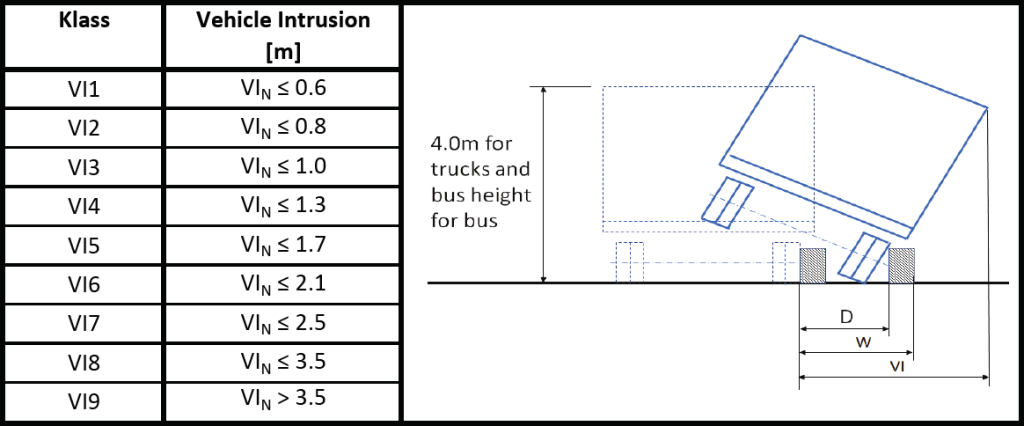- For our products
Regulations
EN 1317–2
EN 1317–2 covers requirements for safety barriers, how they shall be tested and how their properties are to be described.
Containment level
The strength or ability to hold back colliding vehicles is described by the safety barriers containment level. Safety barriers with low angle containment as in classes T1-T3 are intended for temporary use only and cannot be CE-marked. Barriers classified as normal (N), high and very high (H or L) containment level are for permanent use and shall be CE-marked.
Test
The standard defines 11 different tests for safety barriers. These are named TB (test barrier) followed by a two digit number. The first figure, 1 to 8, tells the type of vehicle used and the other, 1 or 2, the approach type (speed and angle) if different such exists.
Example:
- TB31: TB (test barrier) + vehicle type 3 (1500 kg car), test 1 (80 km/h and 20 degrees)
- TB32: TB (test barrier) + vehicle type 3 (1500 kg car), test 2 (110 km/h and 20 degrees)
For containment level N2 or higher at least two tests have to be carried out. Common for these containment levels is that test TB11 always is a part. The TB11-test is performed to prove that the safety barrier is not too hard and does not expose passengers in a small car colliding with it for too hard strains.
The safety barrier’s containment level is determined from tests with heavier vehicles. The mass of these vehicle vary between 1500 kg (TB32) to 38 000 kg (TB81).
To raise the safety of barriers with high or very high containment level an extra test with a heavy car (TB32) can be performed. The containment level of such safety barriers are named L instead of H, for example L1 (with TB32) instead of H1 (without TB32).
Working width
The working width of a safety barrier is a measure of how much space that is needed behind the barrier to allow it to function properly when impacted.
The working width W is the sum of the barrier’s width and the dynamic deflection D at an impact corresponding to the containment level test.
Vehicle intrusion
The vehicle intrusion of a safety barrier is a measure of how much space that is needed behind the barrier at a certain height,
normally 4 m above ground, to prevent the colliding vehicle from bumping into the object protected by the barrier. Vehicle intrusion VI is measured from the traffic face of the barrier and is declared for high containment (H1-H4 och L1-L4) barriers only.
Impact severity level
A safety barrier´s level of impact severity gives an assessment of the safety for occupants in an impacting vehicle. There are three levels; A, B and C. Impact severity level A is the safest for occupants in an impacting vehicle.
Some examples:
- Impact severity class A: safety barrier with W‑profile
- Impact severity class B: vehicle parapet with W‑profile
- Impact severity class C: non deformable concrete barriers
Resistance to snow removal operations
To illustrate how tough a safety barrier is against local damages caused by a snow plough, safety barriers are classified from 1 to 4.
Some examples:
- Class 1: safety barrier with 2 mm W‑profile from steel S420
- Class 2: wire rope fence
- Class 3: safety barrier with 3 mm W‑profile from steel S235
- Class 4: Kohlswa and SF profile





